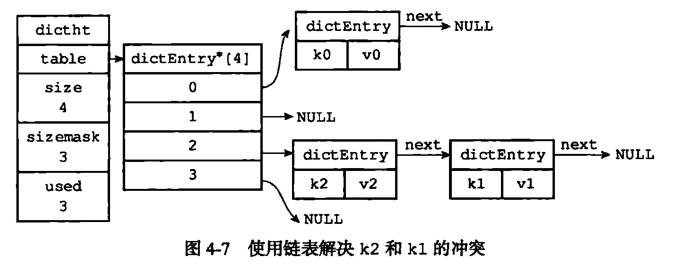链表和字典(dict)是比较常用的数据结构,但是C语言在底层并没有内置这种数据结构,这里通过源码查看这两个数据结构在Redis底层的实现
链表结构
Redis底层使用的是一个双端链表
链表节点结构定义:1
2
3
4
5
6// 双端链表节点
typedef struct listNode {
struct listNode *prev; // 前置节点
struct listNode *next; // 后置节点
void *value; // 节点值
} listNode;
链表迭代器结构定义:1
2
3
4
5// 双端链表迭代器
typedef struct listIter {
listNode *next; // 迭代的指针
int direction; // 迭代的方向
} listIter;
通过迭代器可以比较容易对整个链表进行遍历,从而轻松实现查找等功能。
链表结构定义1
2
3
4
5
6
7
8
9// 双端链表
typedef struct list {
listNode *head; // 头结点
listNode *tail; // 尾节点
void *(*dup)(void *ptr); // 节点值复制函数,可指定复制的方法
void (*free)(void *ptr); // 节点值释放函数
int (*match)(void *ptr, void *key); // 节点值对比函数
unsigned long len; // 链表中所包含的节点数量
} list;
Redis底层中所包含的链表API都是对链表常用功能的实现,比如说插入、删除、搜索等,这里不在解释。
Redis的链表实现的特点有如下几个:
- 双端,方便向前和向后便利
- 多态,链表节点使用void*指针来保存节点值,并且可以通过1ist结构的dup、free、 match三个属性为节点值设置类型特定函数,所以链表可以用于保存各种不同类型的值。
字典
字典,又称为符号表( symbol table)、关联数组( associative array)或映射(map),是种用于保存键值对(key- value pair)的抽象数据结构。
字典在Reds中的应用相当广泛,比如 Redis的数据库就是使用字典来作为底层实现的,对数据库的增、删、查、改操作也是构建在对字典的操作之上的。
字典的实现
Redis的字典用哈希表作为底层实现,哈希表中含有哈希表节点,而每一个哈希表节点就保存了字典中的一个键值对。
哈希表
1 | typedef struct dictht { |
sizemask属性的值总是等于size-1,这个属性和哈希值一起决定一个键应该被放到tab1e数组的哪个索引上面。
哈希表节点
1 | // 哈希表节点 |
Redis中哈希表解决冲突的方法是拉链法,所以其中有next属性指向另一个哈希表节点的指针,这个指针可以将多个哈希值相同的键值对连接在一次,以此来解决键冲突( collision)的问题。
字典
1 | typedef struct dict { |
type属性和 privata属性是针对不同类型的键值对,为创建多态字典而设置的;ht属性是一个包含两个项的数组,数组中的每个项都是一个 dictht哈希表,一般情况下,字典只使用ht[0]哈希表,ht[1]哈希表只会在对ht[0]哈希表进行 rehash时使用。
哈希算法
把一个新的键值对加入到字典中,首先要根据key计算出哈希值和索引值,然后把新的哈希节点加到哈希表数组的指定索引上面:
1 | // 计算哈希值 |
Redis使用的是Murmur算法计算哈希值的,这种算法的优点在于,即使输人的键是有规律的,算法仍能给出一个很好的随机分布性,并且算法的计算速度也非常快。
解决键冲突
Redis采用的是链地址法( separate chaining)解决键冲突的,每个哈希表节点都有个next指针,多个哈希表节点可以用next指针构成一个单向链表,被分配到同一个索引上的多个节点可以用这个单向链表连接起来,这就解决了键冲突的问题。
1 | /* Allocate the memory and store the new entry */ |

重新散列(rehash)
当dict不断进行添加或删除等操作的时候,所保存的键值对也会不断的增加或者减少。为了使哈希表的负载因子(load factor)维持在合理的范围内,此时就需要对哈希表的大小进行相应的扩展或者收缩。
这个工作通过重新散列(rehash)来进行,执行的主要步骤如下:
- 为dict的ht[1]哈希表分配合适的空间,空间的大小取决于要执行的操作和ht[0]哈希表中键值对的数量
- 对所有在ht[0]中的键值对重新计算哈希索引值,将他们转移到ht[1]中
- 释放ht[0],将ht[1]设置为ht[0]
其中负载因子的计算公式为:load_factor = ht[0].used / ht[0].size
渐进式rehash
在进行rehash的过程中需要将所有的键值对从ht[0]迁移到ht[1]中,如果键值对的数量比较大的话,就会导致Redis需要停止一段时间的服务才能够完成这些操作,所以为了避免对服务性能造成影响,rehash并不是一次性的、集中式地完成的,而是分多次、渐进式完成的。
具体的步骤如下:
- 为ht[1]分配空间,同时保留ht[0]和ht[1]两个哈希表
- 在dict中维持一个索引计数变量rehashldx,将其值设为0,表示开始rehash(不工作是为-1)
- 在rehash是,每对dict进行一次操作的时候,除了进行制定操作外还要ht[0]哈希表中rehashldx索引上的索引键值对转移的ht[1]上,完成以后将rehashldx加一
- 当完成了所有ht[0]到ht[1]键值对的转移工作时,表示完成了rehash,此时将rehashldx的值设为-1
在渐进式rehash的过程中,dict同时拥有两个hash表,所以dict的删除、查找、更新等操作会在两个哈希表上同时进行。
1 | // 在rehash期间每进行一次操作,迁移一个索引中所有的键值对 |

